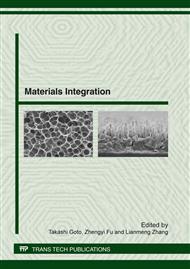[1]
K. Scott, Handbook of Industrial Membranes, first ed., Elsevier Advanced Technology, (1995).
Google Scholar
[2]
C. v. Rijn, Nano and Micro Engineered Membrane Technology, first ed., Elsevier, (2004).
Google Scholar
[3]
A. G. Fane, Norman N Li , W. S. Winston Ho , Takeshi Matsuura, Advanced Membrane Technology and Applications, John Wiley & Sons, New Jersey, (2008).
Google Scholar
[4]
D. Rana, T. Matsuura, Surface modifications for antifouling membranes, Chemical Reviews. 110 (2010) 2448-2471.
DOI: 10.1021/cr800208y
Google Scholar
[5]
N. Hilal, O.O. Ogunbiyi, N.J. Miles, R. Nigmatullin, Methods employed for control of fouling in MF and UF membranes: A comprehensive review, Sep. Sci. & Tech. 40 (2005) 1957-(2005).
DOI: 10.1081/ss-200068409
Google Scholar
[6]
D.S. Wavhal, E.R. Fisher, Membrane surface modification by plasma-induced polymerization of acrylamide for improved surface properties and reduced protein fouling, Langmuir. 19 (2003) 79-85.
DOI: 10.1021/la020653o
Google Scholar
[7]
N. Inagaki, Plasma surface modification and plasma polymerization, first ed., CRC, Lancaster, Pennsylvania, (1996).
Google Scholar
[8]
F. Walther, P. Davydovskaya, S. Zürcher, M. Kaiser, H. Herberg, A.M. Gigler, R.W. Stark, Stability of the hydrophilic behavior of oxygen plasma activated SU-8, J. Micromech. Microeng. 17 (2007) 524.
DOI: 10.1088/0960-1317/17/3/015
Google Scholar
[9]
A. Mata, A.J. Fleischman, S. Roy, Fabrication of multi-layer SU-8 microstructures, Journal of Micromech. Microeng. 16 (2006) 276.
DOI: 10.1088/0960-1317/16/2/012
Google Scholar
[10]
M.E. Warkiani, C.P. Lou, and H.Q. Gong, Fabrication of multi-layer polymeric micro-sieve having narrow slot pores with conventional ultraviolet-lithography and micro-fabrication techniques, Biomicrofluidics. 5 (2011) 036504.
DOI: 10.1063/1.3637630
Google Scholar
[11]
M.E. Warkiani, C.P. Lou, H.Q. Gong, Fabrication and characterization of a microporous polymeric micro-filter for isolation of Cryptosporidium parvum oocysts, Journal of Micromech. Microeng. 21 (2011) 035002.
DOI: 10.1088/0960-1317/21/3/035002
Google Scholar
[12]
M.E. Warkiani, L. Chen, C.P. Lou, H.B. Liu, Z. Rui, and H.Q. Gong, Capturing and recovering of Cryptosporidium parvum oocysts with polymeric micro-fabricated filter, J. Membra. Sci. 369 (2010) 560-568.
DOI: 10.1016/j.memsci.2010.12.038
Google Scholar
[13]
A. Del Campo, and C. Greiner, SU-8: a photoresist for high-aspect-ratio and 3D submicron lithography, J. Micromech. Microeng. 17 (2007) R81.
DOI: 10.1088/0960-1317/17/6/r01
Google Scholar
[14]
S.L. Tao, K.C. Popat, J.J. Norman, and T.A. Desai, Surface modification of SU-8 for enhanced biofunctionality and nonfouling properties, Langmuir. 24 (2008) 2631-2636.
DOI: 10.1021/la703066z
Google Scholar
[15]
F. Walther, T. Drobek, A.M. Gigler, M. Hennemeyer, M. Kaiser, H. Herberg, T. Shimitsu, G.E. Morfill, and R.W. Stark, Surface hydrophilization of SU 8 by plasma and wet chemical processes, Surface and Interface Analysis. 42 (2010) 1735-1744.
DOI: 10.1002/sia.3515
Google Scholar
[16]
M. Sugawara and B. L. Stansfield, Plasma etching: fundamentals and applications, first ed., Oxford University Press, USA, (1998).
Google Scholar
[17]
D.L. Sedin, and K.L. Rowlen, Influence of tip size on AFM roughness measurements, Applied Surface Science. 182 (2001) 40-48.
DOI: 10.1016/s0169-4332(01)00432-9
Google Scholar
[18]
M. Gironès. Inorganic and polymeric microsieves, strategies to reduce fouling. PhD Dissertation, University of Twente, Enschede, The Netherlands, (2005).
DOI: 10.3990/1.9789036522892
Google Scholar
[19]
W.F. Jones, R.L. Valentine, and V. Rodgers, Removal of suspended clay from water using transmembrane pressure pulsed microfiltration, J. Membr. Sci. 157 (1999) 199-210.
DOI: 10.1016/s0376-7388(98)00376-7
Google Scholar
[20]
L. J. Zeman and A. L. Zydney, Microfiltration and ultrafiltration: principles and applications, first ed., CRC, (1996).
Google Scholar



